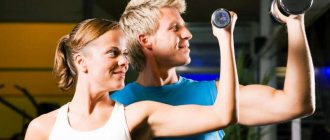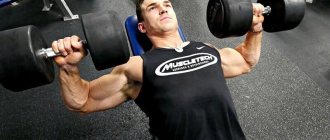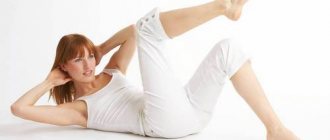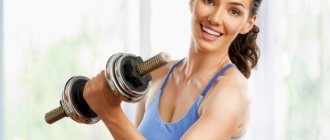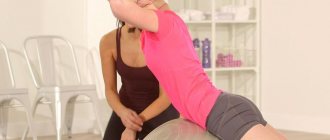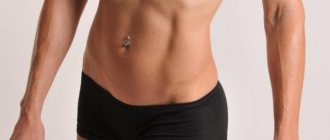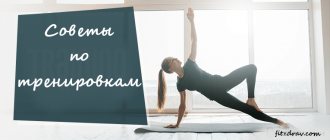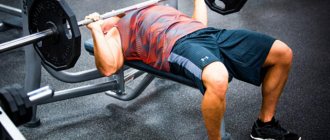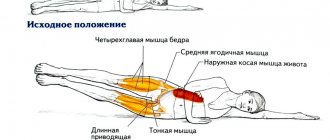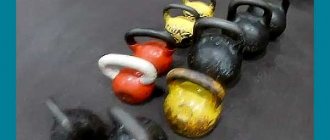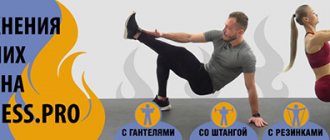Every day a person makes many different movements. And at the same time the spine remains in the correct position. What protects him from various injuries? This function is assigned to the stabilizer muscles. Unfortunately, in most people they are not sufficiently developed. Is it possible to train them? And How?
What are stabilizers?
There are 2 muscle groups in the human body: motors and stabilizers. The former are responsible for the mobility of individual parts of the body.
Stabilizers are a group of muscles that fix the body in a certain position (they do not take part in movement) and protect against various types of damage.
This category includes:
- abdominal muscles (transverse, rectus);
- gluteal (small, medium);
- adductor muscles;
- subosseous;
- thigh muscles (back surface);
- coracobrachial.
Stabilizing muscles are located in fairly deep layers of the human body. They are small in size. However, this does not diminish their importance. The functions they perform are so important, especially for athletes, that there is no doubt about the need to train them.
Do they need to be developed?
Of course, a beginner will have a completely natural question: “Why do you need to train the stabilizer muscles?”
If we talk about sports, these fabrics perform many necessary functions. For example:
- A ski racer uses stabilizers to maintain balance under the influence of a wide variety of factors.
- These same muscles help you lift more weight during strength training. When doing a standing press, no matter how developed the triceps and shoulders are, the load mainly falls on the tissues of the lower back, which provide support for the body.
These muscles are no less important in everyday life:
- Walking and climbing stairs require maintaining balance. To do this, you simply need a fixing ability.
- A sedentary lifestyle leads to severe back pain. The cervical region suffers, discomfort is felt in the thoracic region, and the lower back makes itself felt. Doctors say that such pain is dictated by the underdevelopment of stabilizers, which are not able to properly support the spine.
- Most people dream of excellent muscle definition. This issue is especially interesting for women. To provide the body with relief, it is not enough to exercise only the superficial muscles. It should not be forgotten that the frame is formed by stabilizer muscles. That is why it is necessary to take care of training for them.
Now let's look at the most effective exercises that can strengthen these muscle groups.
Men's training program
To pump up the upper shoulder girdle, you need to use the muscles of the deltas, neck, chest, trapezius, forearms and even the abs during training. Tension and relaxation of muscles perfectly trains and strengthens muscle fiber bundles.
The following effective and time-tested movements should be included in your upper-girdle program:
Arnold press. Iron Arnie himself loves this technique. The technique is simple. You need to take dumbbells, bend your arms at the elbow joints so that the equipment is next to your neck. The palms are turned towards you, and the thumbs look outward. Inhale and smoothly raise your arms up
When the equipment is parallel to the top of the head, you should carefully unfold your palms. We continue to straighten our arms, fix the top point for 1-2 seconds, return to the position from which we started the movement
Raise your arms forward. To perform this, you need to stand straight, take dumbbells in your hands, and turn your palms towards you. We inhale and raise our extended limbs forward. The maximum point is just above the shoulder line. It is important not to change the distance between the dumbbells. An accessible option is to raise your hands one by one
Raising your arms to the sides. The exercise perfectly works the trapezius and deltoids. Starting position – stand straight, legs apart at shoulder level, weights in hands, limbs relaxed along the body. After inhaling, raise your arms to the sides, creating a slight angle at the elbow. You need to lift until your hands are in the same plane as your shoulders. We stop for a couple of seconds and lower our hands. We don’t take a break, but repeat the movement. Dumbbell raises at an angle. The exercise is suitable for performing in the gym. This is where the back of the deltoids work. You need to sit on a sports bench, adjusting the comfortable angle. We stretch our arms with dumbbells straight in front of us. We inhale and as we exhale we spread our limbs to the sides, do not bend the elbow, we work with the shoulder joints. You should not throw your arms at the extreme point; it is important to constantly maintain tension. Pull-ups in different variations. For the arms, chest and back, pull-ups on the horizontal bar are always indispensable. To give different muscle groups a workout, change your grip width. Extensions while lying on a bench with weights. This exercise is very beneficial for the neck. You should lie on a horizontal bench, place a weight plate on the back of your neck, holding it with your hands. Slowly you need to bend and straighten your neck, gradually increasing the amplitude.
If you are training with dumbbells or a barbell, initially use the minimum weight. The load should be increased gradually as the body adapts. Don't train every day, give your muscle fibers time to recover.
Exercise "Plank"
Take a position as if you were preparing to do push-ups on the floor. Arms should be straight. Don't arch your back. You need to stay in this position for a few minutes. You should feel the inner muscles tense. This is the basic level. It perfectly trains the spinal stabilizer muscles.
Exercises based on the “Planck” can vary and become more complex as the athlete prepares:
- plank with emphasis on elbows;
- emphasis on the elbows and raising one leg;
- side stand;
- support on one arm/leg.
Shoulder stretching exercises to improve posture
Now that we understand the importance of this type of training, we will tell you how to stretch your shoulders to improve posture and mobility of the shoulder joint.
Posture correction
This exercise should be the start for the rest of the series of exercises aimed at relieving tension in the shoulder joints.
“This exercise will help many to normalize their posture, straighten the spine, and improve blood circulation,” says Wu.
From a standing position, slouch forward slightly. Don't overdo it, we often find ourselves in a similar position. Then straighten your back, maintaining a slight arch in your back. Our model, physical therapist Rebecca Young, recommends placing your thumb between your shoulder blades to feel movement in the right place: your back and shoulder blades. Repeat 3-5 times in each direction.
Circular movements of the shoulder blades
The exercise sounds pretty simple, but you need to concentrate on isolating your shoulder blades (i.e. don't just move your shoulders up and down).
Start in a comfortable standing position with your arms at your sides. Move your shoulder blades up, then back (as if pushing them away from the body) and down. It is enough to move just a centimeter in each direction. Hold in each position for 10 seconds or more.
Complex "Push-ups"
The exercise is performed in a variety of variations:
- Hand placement. During push-ups, you can spread your upper limbs wide apart. The muscles will be pumped no less effectively if the hands are placed side by side (“grasshopper”).
- Positioning the legs. Perform the exercise with your lower limbs wide apart on a support. Now use a narrow foot stance. Rest your lower limbs on the bench. Try lifting one leg while doing push-ups.
- Unstable support. Such exercises are recommended for professionals. You can lean your hands or feet on the rope.
You should feel how various stabilizer muscles work: back, abdomen, hips.
Exercise "Squat"
There are also various variations for this activity:
- "Pistol." Do squats on one leg. To make it more difficult, you can place the second limb on a stable support or an unstable one. Use TRX loops or their equivalents.
- Regular squats. The exercise is performed on two legs. However, use a narrow or unstable support. You can squat on a bosu (hemisphere).
Complex “Gluteal bridge”
This is a great exercise that will pump up the stabilizer muscles of the spine, buttocks, and abdomen.
The basic version works like this. Lie on your back. Hands - palms to the floor, along the body. Legs are bent at the knees, feet pressed to the floor. Without lifting your head and shoulders, lift your pelvis. Stay in this position for a few minutes.
Advanced athletes can make the exercise more difficult:
- support on only one leg;
- use a hill (bench, unstable support) for the lower extremities.
Exercise "Wheelbarrow"
This complex involves walking exclusively on your hands (your legs must be supported by an assistant). In this case, it is necessary to move forward and then backward. To make this activity more difficult, an assistant can support the athlete with only one leg. This makes it very difficult to hold the body in the required position. But at the same time, the load on the stabilizer muscles is simply colossal.
It has been noticed that the “Wheelbarrow” exercise always increases the athlete’s emotional background. In addition, this complex can be performed for a while, presented as a relay race.
Spinal stabilization
Stability and stability of the spine is important to prevent injury. Additionally, stability is also important when it comes to physical endeavors such as playing sports or lifting weights.
Stuart McGill said that when it comes to the body, "proximal stiffness enhances distal athleticism." This means that when the core muscles around the circumference of your body have enough strength and provide stability to your spine, it will allow your limbs to move more quickly and decisively.
Any athlete who values speed or strength (including powerlifting) can greatly benefit from spinal strengthening training—core training.
A complex that trains the back stabilizer muscles
Exercises to strengthen the corset are performed on the floor, lying on your stomach.
The complex includes:
- Alternately (simultaneously) lift your legs and head and chest off the floor surface. Perform the exercise without delay in the upper position. Then repeat, including a small stop at the top.
- Lift your right arm and left leg off the floor. Be sure to stay late. Then lower yourself to the floor. Repeat the exercise for your left arm and right leg.
- Lying on the floor, imitate the swimming technique.
The best workouts to develop stabilizer muscles
Above was a complex that does not require sports equipment. However, experts have developed certain simulators that allow you to improve exercises for the stabilizer muscles.
The most effective:
- Bosu. This is a special hemisphere simulator. It has an elastic “dome”. Exercises are performed on it in a sitting, lying, standing position (one/two legs). This platform is quite unstable. To maintain balance while on it, you need to tense almost all the muscle tissue of your core.
- Fitball. This is a popular accessory for sports. It is a big elastic ball. You can sit on it, lie down or lean on it. At the same time, it will constantly roll back. Use this exercise machine for push-ups (it will become a support for your legs) and abdominal pumping.
- Medball. It is also called a medicine ball. The dimensions of a medicine ball are much smaller than a fitball. It resembles a basketball. But it is distinguished by its noticeable weight - from 1 kg to 27. They use a medicine ball for push-ups and abdominal crunches.
- TRX hinges. An excellent product that strengthens stabilizer muscles. This versatile exercise machine develops endurance, strength, improves coordination, and builds balance and balance. Using this simulator, you can complicate a variety of exercises.
Training with a gymnastic ball[edit | edit code]
Like any other object used in specific training, a gymnastic ball (also called a fitball) is nothing new. This element was first used in the 1960s, and since then it has gained wide popularity, especially when used for rehabilitation purposes. Since the 1990s, the gymnastic ball has also become widely used for sports and fitness. The popularity of this element in fitness is easily explained, given that the main characteristic features of this type of sports activity are a variety of exercises and pleasure.
Performing exercises using a gymnastic ball helps strengthen the muscles of the upper and lower body, develop overall flexibility and, of course, the core muscles. However, some representatives of the sports community, who argue that improving proprioception and balance have an impact on the overall performance of the athlete, overestimate the positive effect of these exercises. In fact, balance does not limit overall performance in any way and is a skill in a different category than speed, strength and endurance.
In addition to the above, athletes and coaches should be aware that working with an exercise ball during the maximal strength development phase can have a detrimental effect on the athlete's performance. The ball limits the amount of weight an athlete can lift because it requires more neural stimulation to stabilize the body as a whole, as well as individual joints, resulting in less activation of the fast-twitch fibers of the prime mover muscles. Accordingly, it is recommended to use only exercises with a gymnastic ball that are aimed at training the abdominal muscles and provide a complete stretch of the athlete's abdominal muscles to the concentric part of the exercise. There are more effective means for training other muscle groups.
Gymnastic balls should be used at certain stages of training. The process of overstimulation shows how all the muscles involved during a movement participate and interact. Our body is very flexible and adapts remarkably well to traditional training methods. More importantly, the performance of an athlete's body depends on the level of adaptation that creates natural resilience.
Reviews from people
You can develop stabilizer muscles at any age. Such training is suitable for children, they will be an excellent support for the adult population, and will bring invaluable benefits to the elderly. People testify that the development of stabilizer muscles can significantly strengthen the back corset. And this, in turn, relieves the population from unpleasant back pain.
However, despite the obvious benefits, these complexes have some contraindications. Therefore, people who have problems with joints or spine should definitely consult with a competent doctor.
Development of stabilizer muscles[edit | edit code]
Source: "Training Programs"
, scientific ed.
Author:
Professor, Doctor of Science Tudor Bompa, 2020
Propulsion muscles work more effectively when combined with strong stabilizer or anchor muscles. Stabilizer muscles contract primarily isometrically to stabilize a joint so that an action can be performed by another part of the body. For example, during elbow flexion, the shoulders are fixed in a stationary position, and the abdominal muscles act as stabilizers when throwing a ball with the hand. When rowing, when the muscles of the torso act as stabilizers, the torso transfers the power of the legs to the arms as the oar passes through the water. Accordingly, weak stabilizer muscles block the ability of driving muscles to contract.
If the stabilizing muscles are not properly developed, the core muscles may also become impaired. With chronic exercise, spasm of the stabilizer muscles may occur, which limits the work of the moving muscles and reduces the athlete’s performance. A similar situation is often observed in volleyball players who are injured as a result of poor muscle strength and imbalance in the muscles of the shoulder girdle[1]. The infraspinatus and supraspinatus muscles of the shoulder girdle are responsible for rotating the arm. The simplest and most effective way to strengthen these muscles is to rotate your arms with dumbbells. As a result of the resulting resistance, two muscle groups that stabilize the shoulder are stimulated. External (external) rotation of the hip joint is carried out due to the work of the piriformis and gluteus medius muscles. To strengthen these muscles, the athlete must take a standing position with fixed knees and lift the leg to the side using the load from the crossover exercise machine.
Stabilizing muscles also contract isometrically, resulting in immobilization of one part of the limb and movement of the other. In addition, these muscles control the interaction of the long bones in the joints and signal the risk of injury as a result of improper exercise technique, improper strength, or spasms that occur due to lack of stress management. If one of these conditions is met, the stabilizer muscles limit the work of the prime mover muscles, preventing the risk of strain or injury.
The above suggests that stabilizer muscles play an important role in improving the performance of athletes. On the other hand, some strength and conditioning coaches have recently placed too much emphasis on developing stabilizer muscles, especially through proprioception training (also called balance training). In fact, training on an unstable surface causes activation of the upper motor units as a result of simultaneous muscle contraction (meaning the simultaneous contraction of agonist and antagonist muscles to stabilize the joint), which does not lead to the neuromuscular adaptations that are necessary for athletes participating in speed-strength sports. These athletes require that antagonist muscles (i.e., passive muscles) be at rest during forceful activities.
On the other hand, many studies have shown that proprioception training using balance boards helps strengthen unstable or previously injured ankles[2][3][4]. Current theory suggests that if balance board training improves stability by improving proprioception and strengthening the stabilizer muscles of an unstable structure, the training will also provide further muscle strengthening and reduce the risk of muscle injury by providing a stable structure. However, this effect has not yet been proven, and the question of how much time should be devoted to exercises designed to strengthen stabilizer muscles remains unresolved.
Some studies suggest that proprioception may reduce the risk of knee injury[2], while other studies argue against the usefulness of proprioception training as a means of injury prevention[5]. In particular, a recent peer review study examined pitfalls in the design and implementation of proprioceptive learning outcomes[6]. Additionally, reports from strength and conditioning coaches who completely ignored the use of balance boards or proprioceptive training in team sports (soccer and volleyball) suggest that knee and ankle injuries remained unchanged in over the past 10 years.
Taking into account the above, we can conclude that training using a gymnastic ball or balance board can be useful in the early stage of the preparatory stage (anatomical adaptation stage). Of course, unilateral exercises are the optimal choice for improving joint strength while training the prime mover muscles. Proprioception training is good for the anatomical adaptation stage, but at a later stage the exercise ball and balance board should be put aside to free up time to train the athlete using techniques that directly improve his physical condition and promote the development of specific strength, speed and endurance. In general, even if the athlete’s proprioception has improved as a result of the exercises, the regularity and slowness of these exercises do not protect the joint from sudden and powerful movements performed during sports [7]. Preparing the stabilizing muscles for movement plays an important role: in particular, to ensure high performance and optimal fitness of the athlete, it is vital to train the movements specific to a particular sport at the appropriate level of specific speed, strength and endurance.
The table shows the breakdown of a young football player's work schedule over three weeks during the macrocycle of anatomical adaptation. Pay attention to the large number of unilateral exercises, the same amount of work performed by the agonist and antagonist muscles, the duration of the sets under load, which does not exceed the range of the lactate system (from 48 to 80 seconds), gradually increasing the load and shorter duration macrocycle, which is typical for young athletes and professionals. Below is a point-by-point description for each column in the figure:
- sets: each number represents the number of sets performed during a particular week. For example, 2-3-2 means two sets are performed during the first week, three sets during the second week, and two sets during the third week;
- Repetitions: Each number represents the number of repetitions performed during a particular week. For example, 20-15-12 means 20 reps per set are performed in the first week, 15 reps per set in the second week, and 12 reps per set in the third week;
- Rest Break: Each number represents the length of rest between sets of exercises for a given week. For example, 1-1-1.5 means that during the first week the rest break between sets lasts one minute, during the second week - one minute, during the third week - one and a half minutes.
- repetition time: the first digit displays the duration of the eccentric phase in seconds, the second digit displays the pause between the eccentric and concentric phases, and the third digit displays the duration of the concentric phase (X indicates the explosive phase);
- Load: These columns are used to record the weekly load for each set of each exercise.
Rough breakdown of a young football player's three-week work schedule during the macrocycle of anatomical adaptation
| Exercise | Approaches | Repetitions | Rest break (min.) | lead time | LOAD | ||
| 1 Week | 2 week | 3 week | |||||
| Workout A | |||||||
| Single leg squats | 2-3-2* | 20-15-12* | 1-1-1,5* | 3-0-1** | |||
| Single leg curl | 2-3-2 | 20-15-12 | 1-1-1,5 | 3-0-X | |||
| Single leg deadlift | 2-3-2 | 20-15-12 | 1-1-1,5 | 3-0-1 | |||
| Extension of the gluteal muscles and quadriceps | 2-3-2 | 20-15-12 | 1-1-1,5 | 3-0-1 | |||
| Working with abductor muscles on the simulator | 2-3-2 | 20-15-12 | 1-1-1,5 | 3-0-1 | |||
| Working with adductor muscles on the simulator | 2-3-2 | 20-15-12 | 1-1-1,5 | 3-0-1 | |||
| Standing calf raise | 2-3-2 | 20-15-12 | 1-1-1,5 | 2-2-1 | |||
| Crunches using weights | 2-3-2 | 20-15-12 | 1 | 3-0-3 | |||
| Workout B | |||||||
| Dumbbell supine press | 2-3-2 | 20-15-12 | 1-1-1,5 | 3-0-1 | |||
| Dumbbell row | 2-3-2 | 20-15-12 | 1-1-1,5 | 3-0-1 | |||
| Seated dumbbell press | 2-3-2 | 20-15-12 | 1-1-1,5 | 3-0-1 | |||
| Dumbbell biceps curl | 2-3-2 | 20-15-12 | 1-1-1,5 | 3-0-1 | |||
| Front and side elbow stand | 2-2-1 | 30-30—45 (sec.) | 0,5 | Isometric | |||
*For each triple of digits in this column, the first digit refers to the first week, the second digit refers to the second week, and the third digit refers to the third week.
**In each triple of numbers in this column, the first number represents the duration of the eccentric phase in seconds, the second number represents the duration of the pause between the eccentric and concentric phases, and the third represents the duration of the concentric phase (X indicates the explosive phase).
